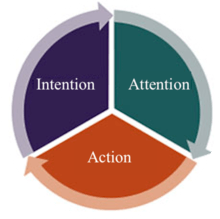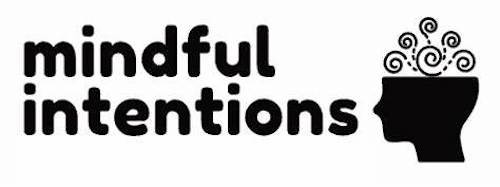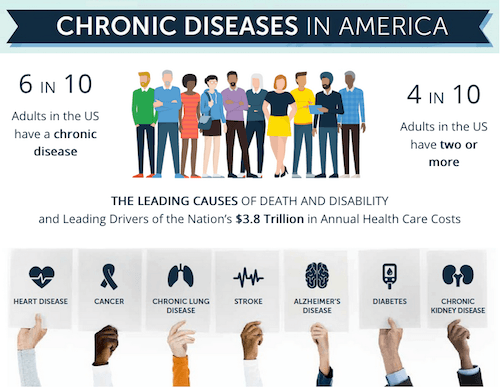Mindful Intention: The Longevity Mindset, Part 2

Mindful intention! That’s step #2 in a four-step process of establishing the Longevity Mindset. You need to both intend to do the work, and the mind to carry it out.
Mindful Intention is part of the Longevity Mindset, one of five modules from the "age-proof" online video course I'm sharing as I develop it, sans the video. If you're not already a Subscriber, click here to be notified when the course goes live.
Mindful intention is the second key puzzle to put in place to achieve the Longevity Mindset, because you can not make the substantial age-changing modifications to your lifestyle if you’re not mindful of what might block you from doing so. That hurdle is your own mind.
There are four parts to the puzzle of developing the Longevity Mindset:
- The Age-proof Brain provides the physical capacity (Part 1)
- Active Mindful Intention sets the stage (covered here in Part 2)
- Tiny Habits guides your actions (Part 3)
- Meditation keeps your clear (Part 4, forthcoming)
Part 1 focused on the machine that enables the mind to exist, our brain. There I introduced the radio metaphor where the brain is the radio, and the mind comprises the radio waves it broadcasts. If the radio gets broken, so do the radio waves. The radio becomes pretty much useless if it can’t, in effect, communicate.
The question is: What is being said?
The answer to this question is what we explore here in Part 2 of the Longevity Mindset — Mindful Intention.
Here's what we cover in this post:
- The power of intentional mindfulness
- Intention activates the journey
- Tame the mind
- Be actively mindful
- Fuel your sense of purpose with loving kindness
- How to practice active mindful intention
- The intention part
- The mindfulness part
- The loving kindness part
- What does all this have to do with longevity?
The Power of Intentional Mindfulness
 Here we explore intention, the unruly mind, active mindfulness and loving kindness. Each are important component parts of intentional mindfulness.
Here we explore intention, the unruly mind, active mindfulness and loving kindness. Each are important component parts of intentional mindfulness.
Intention Activates The Journey
Before you can understand your own mind, you need to observe and then mitigate the static produced by those conflicting and self-destructive thoughts, emotions and judgements that comprise your attitudes about whatever you encounter in life.
This requires intention. To begin the journey to the Longevity Mindset, you must:
- Cultivate and practice intention.
- Intend to do the work needed to extend your healthspan by identifying yourself as someone who can and will adopt the lifestyle habits that can reduce your aging rate and live a long and strong life.
- Exercise the intention to be the Observer. As the Observer, you must watch the thoughts your mind produces.
- Cut through the static and tune in clarity.
This sets the stage for everything else you’re going to need to do to age better than most humans. You’re going to need to abandon limitations, and embrace potential.
Here are some examples of clear intentions you can set:
- I intend to lead by example
- I intend to love unconditionally
- I intend to stop taking things personally
- I intend to manifest happiness naturally
- I intend to see the goodness around me
- I intend to be grateful for all the goodness around me
- I intend to practice loving kindness even when under pressure
- I intend to practice active mindfulness
- I intend to break the habits that age me
- I intend to build the habits that will lengthen my healthy lifespan
Tame The Mind
Watch your thoughts; they become words. Watch your words; they become actions. Watch your actions; they become habit. Watch your habits; they become character. Watch your character; it becomes your destiny.
Tao Te Ching, the founder of philosophical Taoism.
Let’s begin with getting some clarity about the mind.
What is the mind?
Is it your brain, is it “you”.
When you say, “my body, my brain, my life”… what’s the “my”… is that the mind talking?
This seems like semantics, but I have a point to make: We really don’t know who we are. We tend to think we are what we do and what we think, but all that is shaped by other things — that is, until you rein in your unbridled mind and exert control.
“The mind is the set of faculties including cognitive aspects such as consciousness, imagination, perception, thinking, intelligence, judgement, language and memory, as well as noncognitive aspects such as emotion and instinct.”
The brain is an organ but the mind isn’t. The brain is the physical place where the mind resides. The mind is the manifestation of thought, perception, emotion, determination, memory and imagination that takes place within the brain. Mind is often used to refer especially to the thought processes of reason, but sometimes it seems very unreasonable.
The mind can be a wild beast that tramples over you. It must be tamed by intentional, active mindfulness. You need to be aware when your mind evokes thoughts that can undermine your intention. When that happens, you need to stop those self-sabotaging thoughts and replace them with the thoughts that support your intentions.
Read my post, Are Your Thoughts Yours
Be Actively Mindful
To be actively mindful is to put mindfulness into practice.
Practice is active, not passive. Practice is not sometimes here and there, but on a schedule.
Your mind is buzzing all the time, creating all that static that confounds your life, so you must be vigilant on a regular basis. The objective is to notice and then root out those thoughts, emotions, beliefs and attitudes that do not serve you well, that trip you up and keep you from being who you want to be and getting what you want to have.
In a few minutes, I’ll tell you how to use your phone and some breath work to become actively mindful.
Fuel Your Sense of Purpose With Loving Kindness
Are you worth it?
Think about that question for a moment.
As I explored in my post, Create Your Day in 5 Minutes, if you feel unworthy then why would you go through the trouble of breaking the inertia of your life in order to make something new happen? In order to get started with this mindfulness work, you need to know you’re worth devoting the required time and energy.
Then you have to treat yourself with loving kindness, both for yourself and everyone else you encounter. You may not expressly focus on this during your mindfulness practice, but just by doing it you’re being kind and loving to yourself. This state of being emanates out from you and onto everyone else. You can not be peaceful with others, if you are not at peace with yourself. You can not forgive others if you haven’t forgiven yourself. And you can not offer or emanate loving kindness to others if it hasn’t been cultivated within yourself.
As is often the case with loving kindness, the more it’s expressed in conscious thought, deed and expression, the more harmonious will be your life, and that of those around you. If you struggle to discover what your life’s purpose is, step back and focus on making loving kindness the underlying intention of all your thoughts and deeds. Let it be your sense of purpose by default, because a life tuned to loving kindness is of equal emotional satisfaction to one lived with knowable, exercised purpose — and it just might be a more assured way to find it.
Surely, it’s a worthy journey.
To find out if having a sense of purpose has an effect on aging and adult development, Patrick Hill, an assistant professor of psychology at Carleton University in Ottawa, Canada and his colleague Nicholas Turiano of the University of Rochester Medical Center, looked to see how more than 6,000 people answered questions like, “Some people wander aimlessly through life, but I am not one of them,” and other questions that gauged positive and negative emotions.
They found that 14 years after those questions were asked, people who had reported a greater sense of purpose and direction in life were more likely to outlive their peers; they had a 15% lower risk of death compared with those who said they were more or less aimless. It didn’t matter when this sense of purpose was unearthed didn’t matter — it could have been in their twenties, fifties or seventies.
Dr. Hill’s analysis controlled for factors known to affect longevity, such as current age, gender and emotional well-being, and found that a sense of purpose was the strongest determinant studied. Interestingly, we’re not talking about some epic get-your-name-in-the-history-books type of purpose, but things far more mundane such as ensuring that your family is happy, performing well at work, or being creative, such as producing a work of art (whether museum worthy, or not).
The key attribute for this sense of purpose is that it provides a needed compass, road map or lighthouse that guides our intention and the interactions of our day-to-day lives. If you think this is all silly-talk, pay attention to the science.
How To Practice Active Mindful Intention
Until you have some capacity to be mindful, you have no choice but to be lost in every next thought that arises.
Neuroscientist Sam Harris
This section is entitled, How to practice active mindful intention for a very good reason — each word describes an action:
- You need to consistently practice this to get better at it.
- This is not a passive proactive, but an active one that seeks to put you in control of your mind.
- You need to be vigilantly mindful of what thoughts and emotions your mind propigates in order to understand how your attitudes are formed, and thereby be empowered to change them, if needed.
- Intention kick-starts it all — you have to have the desire to do the work.
The Intention Part
First, you must have the requisite desire to intend to by mindful of how your thoughts and emotions shape your attitudes. Then you need to enter the role of the Observer and monitor the static your mind makes. Tune into that and examine those thoughts that undermine what you want out of life.
Why are such thoughts there? Where do they come from? How can you excise them? What self-affirming thoughts to you replace them with?
The Mindfulness Part
You set the intention and now you must follow through by being mindful of your thoughts and actions. Do this:
>> Set the timer on your cell phone to ring every hour. When you hear the ring, stop what you’re doing and take a look at what you’ve been thinking.
>> If you find yourself to be anxious or harried or have been pulled down into some negative emotional vortex, do the 4x4x4 technique:
-
- Get comfortable
- Close your eyes
- Slowly inhale through your nose to the count of four (or whatever you can easily manage)
- Expand your chest, abdomen and back as you inhale
- Hold your breath for a count of four (or whatever you can easily manage)
- Exhale to the count of four
- Pause for a count of four
- Repeat
The U.S. military is taught this technique to stay calm under fire, so surely it will work to mitigate whatever is stressing you.
The Loving Kindness Part
This is the countenance you bring to your mindfulness practice. Don’t be some hard-ass Viking that’s going to knock yourself down with Thor’s Hammer, but rather approach this practice with loving kindness in your heart.
Unfortunately, our brains are wired for negativity, but you can rewire your brain to make your life upbeat and positive in just 30 seconds a day. As I wrote in my post, Rewire Your Brain In 30 Seconds where you can get the specifics:
- Notice the negativity bias
- Shift to a moment of gratitude
- Rewire your brain by bathing in this new mindset for 15 seconds or longer
The older we get, the more time we’ve had to experience hardship and disappointment. This can shape who we are for bad or good. When you seek to unwind the heartache, do it with loving kindness. Just let that be your attitude.
What Does All This Have To With The Longevity?
Right now you’re probably aging pretty much the same as everyone else is aging.
If that’s the case, according to the CDC, this is what’s in store for you:
Mostly, this is due to lifestyle choices:
Those with one or more chronic diseases typically age at an accelerated rate. And although the lifestyle risks indicated above induce chronic disease, “the greatest risk factor for a majority of chronic diseases driving both morbidity and mortality” is aging, says the study, Geroscience: linking aging to chronic disease.
So, of course, for healthy aging to happen you need to not smoke, not drink alcohol excessively, have a nutritious diet and exercise regularly.
That’s the bare minimum.
If you want more… if you want to reduce your biological age, as I’ve done, you must cultivate the Longevity Mindset, because there’s a lot of work that needs doing, and your mindset is the key to getting it done.
Next up in the Longevity Mindset is Part 3 — Habit Making. If you’re a Subscriber, you’ll get an email when Part 3 is ready.
See you then.
Go To Part 3
Last Updated on November 3, 2022 by Joe Garma





